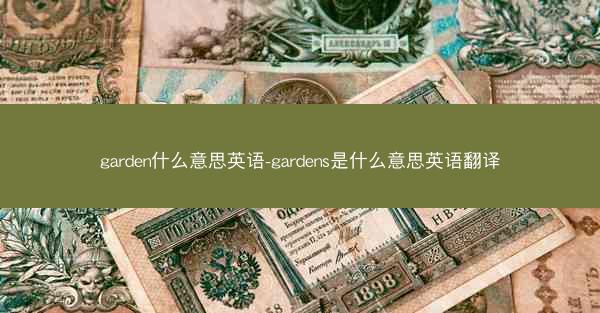garden什么意思英语-gardens是什么意思英语翻译

Introduction to the Word Garden in English
The English word garden refers to an area of land, usually attached to a house, where plants are cultivated for beauty, food, or leisure. It is a space where nature and human creativity intersect, offering a retreat from the hustle and bustle of everyday life. The concept of a garden is deeply rooted in human history, serving various purposes over the centuries.
Definition of Garden
At its core, a garden is a planned space, often located near a home, where plants are grown. These plants can range from flowers to vegetables, herbs, and even fruit trees. The term garden is often used to describe a variety of settings, from small urban balconies to expansive country estates.
Types of Gardens
1. Formal Gardens: Characterized by symmetry and geometric shapes, formal gardens often feature pathways, hedges, and a structured layout.
2. Informal Gardens: These gardens are more natural in appearance, with winding paths and a less rigid design.
3. Japanese Gardens: Known for their minimalist aesthetic, Japanese gardens often include elements like rock formations, water features, and cherry blossoms.
4. Italian Gardens: Typically grand and opulent, Italian gardens are often designed with a focus on symmetry and grandeur.
5. English Gardens: These gardens are known for their lush greenery, flower beds, and often include a mix of formal and informal elements.
Historical Significance of Gardens
3. Medieval Gardens: During the Middle Ages, gardens were primarily for the wealthy and were used for medicinal plants and herbs.
4. Renaissance Gardens: The Renaissance period saw a shift towards more decorative gardens, with an emphasis on flowers and ornamental plants.
5. Victorian Gardens: The Victorian era was marked by the popularity of large, ornate gardens, often featuring elaborate flower arrangements and water features.
6. Modern Gardens: Today, gardens continue to evolve, with a growing interest in sustainable and eco-friendly designs.
Purposes of Gardens
1. Aesthetic Pleasure: Gardens are designed to be visually appealing, offering a serene and beautiful environment.
2. Food Production: Many gardens are used to grow vegetables, fruits, and herbs for consumption.
3. Leisure and Relaxation: Gardens provide a peaceful retreat where individuals can unwind and enjoy nature.
4. Therapeutic Benefits: Spending time in a garden has been shown to have numerous health benefits, including reduced stress and improved mental well-being.
5. Educational Opportunities: Gardens can be a valuable tool for teaching children about nature, biology, and environmental stewardship.
Design and Maintenance of Gardens
1. Planning: Before starting a garden, it is important to plan the layout, considering factors such as sunlight, soil type, and water availability.
2. Soil Preparation: Good soil is essential for healthy plants. It may require amending with compost or other organic matter.
3. Plant Selection: Choosing the right plants for the garden's climate and conditions is crucial for success.
4. Watering and Fertilization: Regular watering and fertilization are necessary to keep plants healthy.
5. Pest and Disease Control: Monitoring for pests and diseases and taking appropriate action is important to protect the garden.
6. Pruning and Maintenance: Regular pruning and maintenance help keep the garden looking its best and ensure the health of the plants.
Conclusion
The word garden in English encompasses a rich tapestry of history, purpose, and design. Whether it's a small urban oasis or a sprawling country estate, a garden is a testament to the human desire to connect with nature. From their historical significance to their modern applications, gardens continue to be a source of beauty, sustenance, and tranquility.










